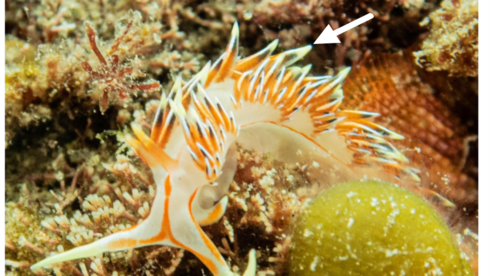The study, published in the journal Frontiers in Zoology, found that the sea slug, Caloria militaris, native to the Indian Ocean, can survive and thrive by feeding solely on jellyfish polyps, such as the nomad jellyfish (Rhopilema nomadica).
Although it preys on these polyps, a small and hidden stage of the jellyfish life cycle that attaches to rocks and releases young jellyfish into the water, the sea slug does not incorporate the polyps’ stinging capsules into its body.
Sea slug preys on jellyfish polyps
(Photo: Hila Dror)


“The findings indicate that this sea slug may influence the size of jellyfish blooms in the eastern Mediterranean. Since polyps are a critical part of the jellyfish life cycle, the heavy predation by the slug could affect the frequency and intensity of jellyfish blooms in the region”, said Dr. Dror.
Over the past few decades, massive jellyfish swarms have become increasingly common in the eastern Mediterranean, affecting marine ecosystems, the fishing industry, coastal recreation, and infrastructure such as power stations and desalination plants.
Jellyfish have a complex life cycle that includes a free-swimming stage and a benthic polyp stage, which involves releasing young jellyfish into the water in warm seasons. Because polyps are tiny and often hidden, their natural habitats remain largely unknown, and little is understood about the creatures that feed on them.
In the study, Dr. Dror and Prof. Dror Angel of the Department of Maritime Civilizations and the Recanati Institute for Maritime Research at the University of Haifa, together with Prof. Tamar Lotan of the Charney School of Marine Sciences at the university of Haifa, investigated whether sea slugs found along Israel’s coast could survive long-term on jellyfish polyps and whether they incorporated the stinging capsules as part of their defense mechanism, as other species do.
The researchers raised sea slugs collected off Israel’s coastline, observed their interactions with jellyfish polyps commonly found in the Mediterranean, and monitored their feeding behavior and movement during hunting. They also tracked the slugs’ feeding rates and survival.
Using microscopy, the scientists examined the slugs’ dorsal lobes to determine whether they incorporated the stinging capsules of their prey. As a control, they also examined wild sea slugs that had fed naturally.
The results showed that Caloria militaris could survive for as long as 255 days feeding exclusively on jellyfish polyps, consuming up to 192 polyps a day, without incorporating any of the prey’s stinging cells into its own defense system.
In contrast, when feeding on other stinging animals, the slug did absorb the capsules and used them for protection. “This sea slug demonstrates a remarkable survival strategy: it feeds on jellyfish polyps but chooses not to use their stinging capsules, despite them being among the most effective defense tools in nature,” the researchers concluded.
“This is the first recorded case of a sea slug with an active defense system that entirely avoids incorporating jellyfish stingers, a sign of a unique selectivity among sea slugs”, concluded the researchers.
